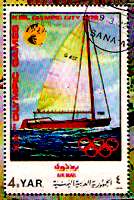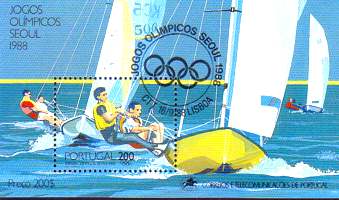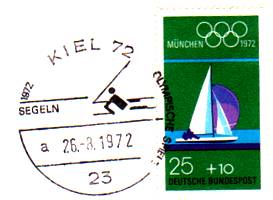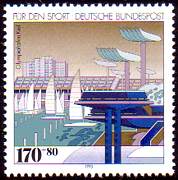|
Maritime Topics On Stamps

|
The origin of the ancient Olympic Games probably extends back to the 2nd millenium BC. The first
regular games took place in 776 BC in the Greek city of Olympia. This time was deducted from
very early winner lists.
The old Olympic Games were forbidden in AD 394 by order of the roman emperor Theodosius I
for worshipping pagan gods.
The first Olympic Games of the modern times took place in April 1896 in Athens.
|

| |
In old times it was common and it is still like that today: If two sailing boats meet at sea,
a small "private race" ensues where everyone wants to get ahead of the other boat.
This page is about stamps and proofs about the olympic sailing races.
There are more than 200 postmarks, innumerable stamps and covers in existence - therefore only a
small selection can be shown here.
|

|

| |
Sailing became part of the olympic event calendar starting with the summer games 1900 in Paris.
|
The boats were divided into seven separate classes:
- up to 0.5 tons,
- 0.5 to 1 ton,
- 1 to 2 tons,
- 2 to 3 tons,
- 3 to 10 tons,
- 10 to 20 tons and
- 20 tons and more.
This division only lasted for the 1900 Olympic Games.
|
The boats were rigged with mast, gaff and topsail aft, and foresail and jib on a bowsprit.
One had to register boats instead of crews for the regattas and only the owner was recorded
for the winners list. Of course the boats had regular crews, but it is not known if
they actually sailed the race.
|

This dutch stamp for the 1928 Olympics depicts a boat of the 8-m-R class.
From 1904 to 1928 the dinghy classes also took part in the Olympics in addition to the 6, 8, 10, 12-m-R classes.
In 1908 the formula for the so-called 'meter class' was introduced. The formula reduced the parameters
length, width, waterline length, freeboard, depth and sail area to one single number e.g. 8.
Then the boat was assigned to the corresponding class (here 8-m-R).
(R stood for Race, Racing)
| |
This stamp of Monaco was issued for the 1948 Olympic Games in London.
There is a couple of 8-m-R boats, although this class was banned from olympic sailing after 1936.
Compared to the Dutch stamp above the completey different rigs stand out, although both boats belong
to the same class.
|

| |

This stamp for the 1952 Olympics in Helsinki depicts boats of the 6-m-R class.
This class was part of the oylmpic saling events from 1908 to 1952.
Length: ca. 10.5m, width: 1.9m,
depth: 1.6m, sail area: ca. 40 square meters, crew: 5.
| |

|

|
On these three stamps you can see the Dragon class.
This class was part of the olympic program from 1948 to 1972.
The boat was designed by the Norwegian Johan Anker in 1929 as a low-cost, standardized keelboat with a
simple open-topped cabin.
Data: length 8.95m, width 1.9m, depth 1.2m, sail area 27.7 square meters, plus spinnaker 23.6 square meters,
3 crew.
The dragon class became known as the 'kings class' among sailors, as a lot of members of the european
nobility used them for racing. On the top right stamp you can see crown prince Konstantin of Greece
with his boat winning the gold medal in 1960 at Naples.
|

|

For the Olympic Games at Kiel 1936 the "O-Dinghy" (Olympic Dinghy) was constructed.
This wooden boat had a length of 5m, breadth 1.6m, depth of 1.1m at dropped centerboard and a sail of
11.5 square meters. She was sailed by one person.
After World War II many boats of this class sailed in Germany, but no more at Olympic Games.
| |

Left Soling boats, right Star boats.
|

| |
The Starboat (sail sign: a five pointed star) was designed in 1910/11 and is the longest running sailing boat
class in olympic history.
It took part from 1932 up to today with a brief interruption in 1976, when
it was replaced by the Tempest class.
Data: length 6.92m, width 1.73m, sail area 27.92 square metres, 2 crew. It utilized mainsail, jib,
but no spinnaker.
The USA has won seven gold medals in this class. Germany's only win dates back to 1936 with Peter Bischoff
at the helm.
|

From left to right: Star, Soling, 470er, Finn and FD.
1980 Olympic Games in Moscow, races at Tallinn (Reval).
| |
The Soling class (sail sign Omega) was designed as a replacement for the 5.5m class.
The keelboat took part from 1972 to 2000 and was replaced by the Yngling.
Data: length 8.20m, width 1.90m, sail area 24.3 square meters plus 45 square meters spinnaker, 3 crew.
Jochen Schümann, one of Germanys best sailors, won two gold and one silver medal in a Soling.
|

The Tempest (sail sign "T") is a very athletic design using a retractable keel, trapeze and spinnaker.
The class was part of the olympic program in 1972 and 1976 - even displacing the Starboats in 1976,
but this decision was reversed in favor of the Starboats in 1980.
Data: length 6.70m, width 1.97m, sail area 23 square meters plus 21 square meters spinnaker, 2 crew.
| |

|

| |
Olympic sailing is about racing with small boats - not yachts!
Here you can see a Finn dinghy (sail sign: two parallel waves).
The class has been part of the olympic program since 1952.
It was designed by Richard Sarby from Uppsala, Sweden in 1949.
Data: length 4.5m, width 1.51m, one sail with 10 square meters sail area, 1 crew.
The Danish Poul Elvström won three gold medals from 1952 to 1960. In 1964 Willi Kuhweide won gold for Germany,
followed by Jochen Schümann in 1976.
|
The Laser was designed by Bruce Kirby in 1970 as a one man dinghy. He aimed for an inexpensive,
simple and recreational boat. At first it was called 'Freetime'.
There are over 189,000 Lasers in existence (2005) and it became part of the olympic program in 1996.
The sail sign depicts a small red sun.
Data length 4.23m, width 1.37m, sail area 7.06 square meters (Olympics, men) respectively Laser Radial 5.7
square meters (Olympics 2008, women).
The two part mast can rotate freely as there are no stays to hold him upright.
If the Laser capsizes, he could be easily righted by one person alone.
|

To the left a Laser, to the right a Finn dinghy.
|

| |
The 470er is a two man olympic racing dinghy with a trapeze and a spinnaker.
Its sail sign '470' is derived from the length of the hull (4.70m).
It is part of the olympic program since 1972; since 1988 there are also seperate races for women.
The class was designed by Andre Cornu in 1963 in France.
Data: length 4.7m, width 1.68m, sail area 12.7 square meters plus 13 square meters spinnaker, 2 crew.
In 1976 the Germans Frank Hübner and Harro Bode won the gold medal in this class.
|
The Tornado is a two hull sailing boat and the fastest olympic class to date.
The sail sign is a small tornado above two parallel lines which looks like an underlined 'T' from far away.
The Tornado was designed by Rodney March in England in 1967. The class took part in the olympic
program since 1976, but was deselected for 2012.
Data: length 6.10m, width 3.08m, sail area 21 square meters plus 25 square meters gennaker, 2 crew.
At close-hauled courses, one of the hulls usually lifts out of the water thus greatly improving speed.
|

|
The program for the olympic sailing events in 2008 at Qingdao, China consisted of the following classes:
- 470 - men/women
- Laser - men
- Laser Radial - women
- Finn - men
- RS:X - men/women
- Star - men
- Yngling - women
- 49er - mixed crew
- Tornado - mixed crew
To the right you can see a chinese set about sailing for the 2008 Olympic Games.
|

|
The 49ers are a skiff class - the name is derived from the length of the hull, which is exactly 4.99 meters.
The crew consists of two persons running the boat from trapezes.
Ynglings are three person keel boats. Length: 6.35 meters, sail area: 14 square meters close-hauled,
20.4 square meters with spinnaker.
The "Yngling" and "49er" classes were introduced to the Olympic Games in 2000. They are probably not
depicted on a stamp yet.
|

|

|

|

|
The olympic sailing contest in 2008 consisted of 11 peliminary heats (16 for the 49ers) and one medal race.
The winner of a preliminary heat receives one point, the 2nd two points, and so on.
The worst result was not added towards the running total. Points in the medal race counted double.
The crew with the fewest points was the overall winner and received the gold medal.
|

|

|
In 1936 and 1972 the city of Kiel hosted the olympic sailing events.
On the stamp to the right you can see the habour (named "Olympiahafen") at Kiel-Schilksee.
The two white wind plays in the upper right corner probably symbolize sea gulls.
The platform in the foreground held the olympic flame. In the background the buildings for the athletes.
|

|

|
Sources:
Wikipedia Internet encyclopedia
G. Meyer-Uhl, Sportsegeln auf Briefmarken, Delius Klasing, 1979.
|
|